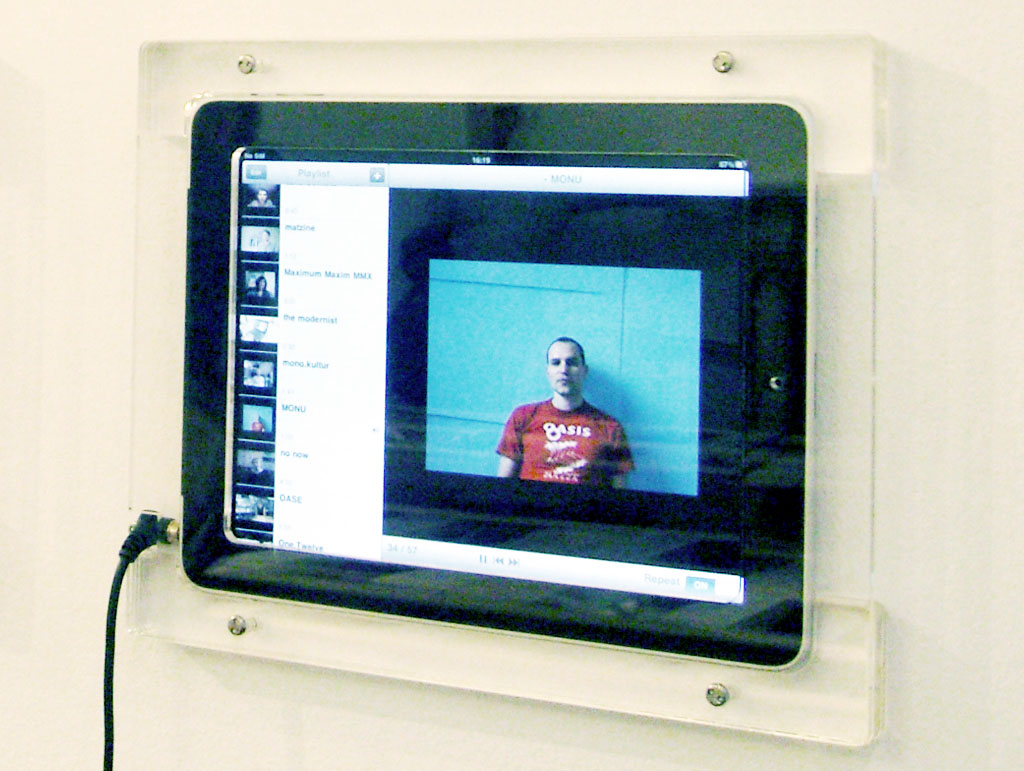22-12-11 // THE PRODUCTION OF ARCHITECTURE AND PUBLICATIONS – INTERVIEW WITH BERND UPMEYER

Bernd Upmeyer’s answers of the interview were screened at the exhibition, ©BOARD
The Architectural Association hosted the ARCHIZINES exhibition in London from 5 November to 14 December 2011. The exhibition showcased 60 architectural magazines, fanzines and journals from 20 countries around the world and included video interviews with their creators. The following answers of Bernd Upmeyer were screened at the exhibition:
ARCHIZINES: What is the relationship between architecture and publishing?
Bernd Upmeyer: To a certain extent, both architecture and publishing can be understood as processes of information production. Yet, neither architecture nor publishing should be completely reduced to the production of information. However, when I started publishing MONU magazine around seven years ago, after having been trained first and foremost as an architect, the first printed issue of MONU became in a way my first fully realized, or to put it more correctly, my first fully built project under my own name. In this way, and from my point of view, publishing and architecture were very closely related. Nevertheless, in my experience, the production of architecture is a much more active and narcissistic process, whilst the production of a publication is far more passive, more mediating and collaborative.
A: How do you ‘edit’ architecture?
BU: MONU magazine is first of all a magazine on urbanism that focuses on cities in a broader sense, including their politics, economies, geographies, their social aspects, but also their physical structures, the point where architecture comes into play. In that sense architecture is only one field of many in the magazine – fields which are all brought together under the umbrella term urbanism. When editing the magazine, I of course always try to select those contributions that are most relevant for the chosen topic for the particular issue in order to come to conclusions regarding the problem under discussion. But what I find actually more interesting about the question “how I edit architecture” is the impact that MONU can have on cities and thus on the built environment – the architecture. Because I believe that by putting certain topics on the agenda, the magazine is actually able to modify and even correct, and therefore “edit”, architecture by changing and manipulating the views and perspectives of its readers in a positive way, which will eventually also influence the built environments in our cities.
A: What is the role of printed matter in the digital age?
Bu: I think that the role of printed matter in the digital age is very much related to the costly, complicated and time-consuming way in which printed publications are produced and distributed. Everybody who has ever produced a printed publication knows what I am talking about. Even if you simply print your magazine on an ink-jet printer in your kitchen and staple it together by yourself, it still remains so much harder to do than publishing something online. And once you have made that kind of effort, you are not going to waste it on low-quality information. That fact alone secures a certain quality among printed publications. Furthermore, I believe that a certain fascination with “materiality”, with real and physical objects will never entirely disappear. Although MONU magazine is already available digitally as well, I could not imagine producing it only digitally at this moment. The idea that a magazine can be a physical object of art and not only a transmitter of information always appealed to me.
A: How are architectural publications changing?
BU: I would be tempted to say that the increased accessibility and availability of information and the easier connectivity between people that the internet provides today, can only be judged positively. But whether it works for you as an advantage or disadvantage depends on your approach. The whole situation offers both: great opportunities, but also great dangers of misuse. Because what I see is that, especially over the last ten years, the situation has impacted and changed architectural publications in a lot of negative ways. The reality that producing a magazine became so much easier and faster than twenty years ago, resulted in the fact that today the shelves of bookshops, but also a huge number of internet websites, are groaning under the weight of an ever-growing stack of rather uncritical, low-quality and image-oriented architectural publications that will eventually hollow out the entire architectural profession.
Title: The Production of Architecture and Publications
Project: Interview with Bernd Upmeyer
Date: December 2012
Type: Commissioned interview
Topic: Architectural magazines
Organizer: ARCHIZINES
Status: Screened at the Architectural Association, London
Publications: ARCHIZINES Catalogue
Interviewer: Elias Redstone